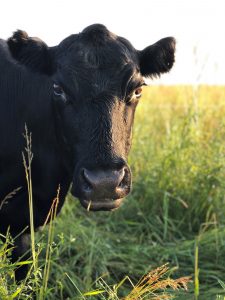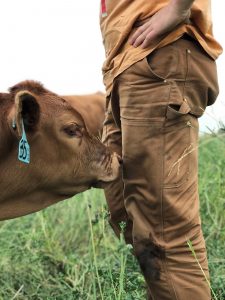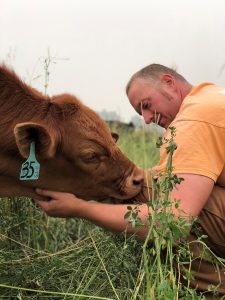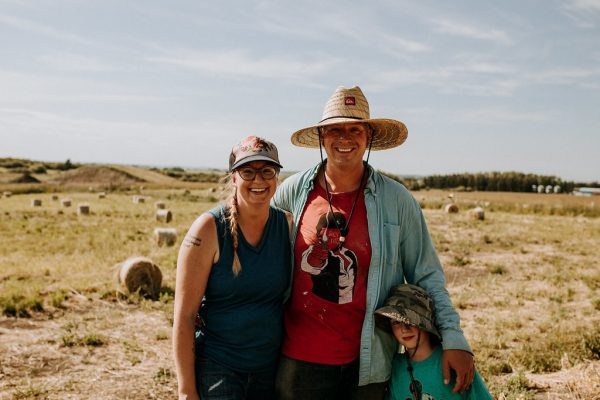How Can Grazing Help Bind Atmospheric Carbon
In today’s Guest Spotlight, farmer Marcus from Happiness by the Acre goes over the nitty-gritty details of grazing to bind atmospheric carbon, how by using livestock in a careful and considered way, it is possible to bind atmospheric carbon into grassland and savanna soils with ease and rapidity. The critical point to consider in this post is that results take time and by treating the animals in their most natural state, providing them with a natural environment, you can begin to see changes in the soil. Read Marcus’ latest contribution below, and as always, feel free to share your comments and suggestions with us, we would love to hear from you!
By using livestock in a careful and considered way, it is possible to bind atmospheric carbon into grassland and savanna soils with ease and rapidity. In particular, the much-maligned ruminants become a vital tool for improving soil health, grassland biodiversity, and mitigating climate change’s growing effects. The major caveat is that you need to treat the grazing livestock in a manner that allows them to manifest their nature fully. Help them emulate herd behaviour that existed before the fences went up, a time when predators still played a role in the day to day lives of our now domesticated animals.
On our farm, we do this using temporary electric fencing to keep cattle in a tight herd. The temporary fencing acts as the predator. We move the cattle each day onto fresh grass, emulating the migratory nature of herd ruminants. Every few days, we move a mobile water trough to a new spot, mimicking the wetlands, ponds, and creeks that used to dot our Alberta landscape. The pastures then get to rest for 40 to 150 days, depending on weather and time of year, mirroring the disturbance/rest cycle that the grasslands experienced with million head herds of bison and frequent grass fires. It makes for a bit more doing on our side, but it is great for the cattle and even better for the soil.
How does this tie into binding atmospheric carbon? The answer to that is in the soil. The primary driver of carbon sequestration is the roots of the pasture plants. These are long-lived perennials that push their roots a meter deep or further. All those roots are primarily made up of carbon pulled from the atmosphere. The trampled plants and manure left behind by the livestock get incorporated into the top 30 centimetres of the soil by hoof action and the community of animals that live there – worms, microarthropods, insects, and so forth. All these biological agents are made mostly from… you guessed it. Atmospheric carbon. Lastly, the long term carbon sequestration happens in plants sloughing off roots and fungus building mycelium networks in the top 50 to 100 cm soil. Between all of these systems, you can bind a lot of atmospheric carbon.
We can measure all of this carbon using a suite of tools in the lab, but for a quick and dirty estimate of how much carbon is binding in this grazing system, we can measure the total organic matter (OM) in the soil. Specifically, we are looking for a change in the OM. If it is going down, we are losing sequestered carbon. If it is going up, we are adding sequestered carbon. Different soils are going to hold different amounts of atmospheric carbon as their OM changes. Most places in the world have baseline data on soil types and how much carbon they can contain when you measure against OM. In our soil type and location, clay-heavy black loam in central Alberta binds 8 to 10 metric tons of atmospheric carbon per acre for every 1% OM at 15 cm depth.
When we took over stewarding the land we are on now, the soil was depleted to 0.5% organic matter in the top 15 cm. In 2016 we did a broad cross farm survey of our soil and found we had brought that up to an average of 2% in the top 15 cm in 4 years through low till, low chemical farming. 2016 was the year we returned this property to pasture. Since that time, we have followed the grazing process above. Our goal was to reach 10% organic matter in the top 15cm within 25 years. In 2020 we did a broad cross farm soil survey again. We had a cross farm average of 8% organic matter, with pockets at 10% in the top 15 cm. With 125 acres of pasture managed this way, that represents an estimated 7,500 metric tons of atmospheric carbon bound into the soil. That is the carbon emissions of 340 Canadian homes for one year, or if we break it up into what we annually bind, 85 households have been made fully carbon neutral for the last four years. That corresponds, roughly, to each customer’s household that gets fed from our farm.
Our new goal is to get the farm average up to 15% organic matter at a depth of 30 cm, with an additional 5% between 30 cm and 45 cm. The deeper we can bind carbon, the longer it will stay sequestered, and the more total soil biology our pastures will support. If we can pull that off, and based on the last four years, this seems attainable within another decade. We will have bound an estimated 38,750 metric tons of carbon from the atmosphere in under 15 years. We think that it is incredible for our soil, livestock, and customers.
Currently, our farm does not qualify for carbon payouts in Canada for the work we are doing; which is a shame as this would represent over $750,000 CND in carbon credits coming to our farm under the current Canadian price for carbon ($20/ton scaling to $22/ton by 2022). (1) But in other nations where farmers can capture financial rewards for changing their practices to bind carbon, this grazing protocol and land stewardship process can really pay for itself and then some.
With over 250 million acres of agricultural lands now under 5% organic matter in North America alone, this represents a considerable carbon sequestration opportunity in our efforts to mitigate climate change. That represents a potential ten gigaton carbon sink at a minimum, by increasing the soil organic matter in just the top 15 cm of soil! If we push on the system and try to rebuild organic matter in the top 100 cm of soil, we could be looking at a potential 75 to 120 gigaton carbon sink, or higher, just by bringing these depleted soils back up to between 5% and 10% organic matter. That is potentially offsetting the global atmospheric carbon output from 2015 to 2020. (2)
Thanks to a few kilometres of temporary electric fencing, a couple of dozen step-in posts, and cattle.
- https://www.canada.ca/en/environment-climate-change/services/climate-change/pricing-pollution-how-it-will-work/industry/pricing-carbon-pollution.html
- These calculations are based on rough numbers. The large scale impact of soil sequestration of carbon is in its infancy in terms of being studied. So take these as loose targets rather than hard and fast empirical data. Our farm, Happiness By The Acre, has partnered in this research through http://www.foodwaterwellness.org/.




About Happiness by the Acre
Happiness by the Acre is a small family farm located on the edge between the Alberta foothills and the open prairie. Dedicated to providing healthy, fresh, local, and ethical food to consumers, they believe that what you eat, and what you choose to support with your purchases, directly impacts how the land is used and how healthy the soil will be.
For more blog content on growing and raising happy food, visit the Happiness by the Acre website at https://happinessbytheacre.ca/
Sarah and Marcus Riedner
[email protected]


